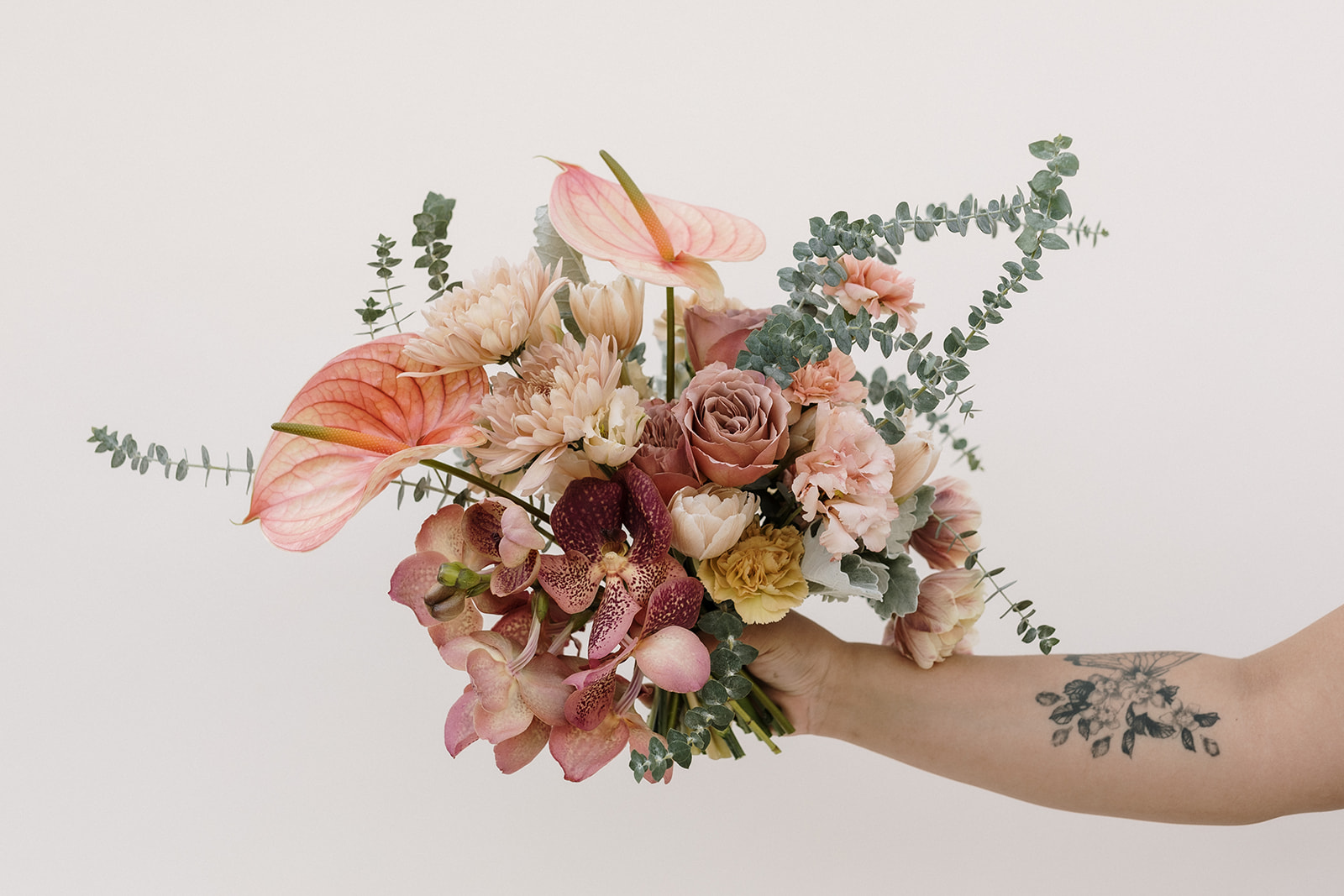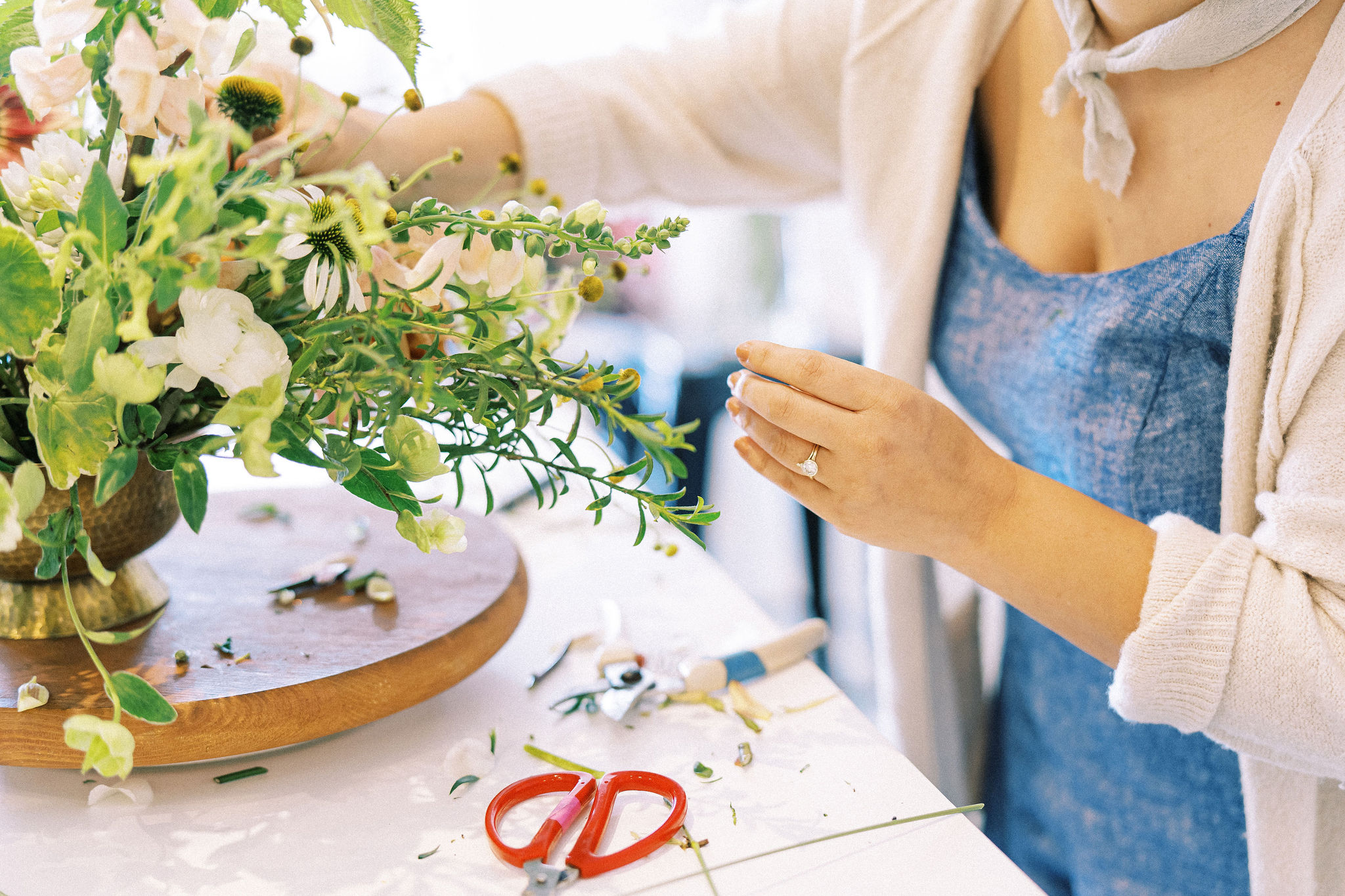Designing With Dahlias
Dahlias are bold, dramatic, and incredibly beautiful. They’re also a good bit of drama to work with… from vase life, shattering petals, bruising, wilt and their flat heads, they can really give us a run for our money.
So, with dahlia season squarely upon us, it’s a great time to dig into some dahlia tips and tricks I have gathered over the years!
- Start with the Right Size
Dahlias are expensive and sensitive blooms, so it’s important that we get the best use out of each stem. The most profitable stem is the right stem, so as I build my recipes, I make sure to be intentional in my selection.
While dinnerplate dahlias, like Cafe Au Lait, are recognizable and popular, they can be difficult to work with. They are sizable, one-sided, and fragile. Now, I won’t shy away from using 1-2 in bouquets if requested, but I prefer to use these stems in large centerpieces, installations and large designs where they are more proportionate.
Medium-to-small dahlias, like ball dahlias, are much easier to utilize in bouquets, and even centerpieces. When using larger dahlias, my recommendation is to use only a few stems with a small design so the dahlias don’t overpower the design and make the shape of the bouquet or centerpiece look strange off balance. In the above design, mixing smaller white dahlias and one large Cafe Au Lait allows for a more blended look while still allowing the Cafe Au Lait to be the “star.”
Another benefit of working with ball dahlias or smaller varieties? They are less likely to lose petals and fall apart. This is beneficial for bouquets, as they get handled heavily during wedding day and in market bouquets.
- Source from a Reliable Place
Most dahlias have a three to five day lifespan, seven if we’re being generous and depending on the variety! So it’s important to get your dahlias from a reliable source that can offer you the best quality possible.
Local dahlias tend to hold up well as they are harvested and placed directly into water where they stay until delivery. Local growers often have the most compelling selection of colors and sizes as they aren’t packed flat in boxes and shipped. They are often more likely to experiment with specialty varieties and unique shapes that don’t travel well.
If dahlias are not available to you nearby, Alexandra Rose Farms grows and ships 12 varieties of dahlias with year-round availability! I received dahlias in locations all across the U.S. and at all different times of the year over my 2023 Design Tour with Mayesh Wholesale. The dahlias are shipped with netting over their heads (like a disbud chrysanthemum) and stripped of all foliage. These extra steps from Alexandra Farms make a marked difference in the quality of the stems. Give them a day to open up and hydrate and they are GORGEOUS! The picture below of dahlias that were flown in off season from Alexandra Farms!
My favorite two colors are the Hybird Brickstone and Cafe Au Lait. I had the pleasure of also visiting the farm and seeing first hand how amazing the whole operation is, you can read more about that here.
Hybrid Pink Quartz Dahlias from Alexandra Rose Farms.
- Properly Condition and Prepare Them
Dahlias are fragile. Upon receipt, unpack dahlias immediately to avoid any warm air from being trapped. check their quality carefully. This blog post has everything you need To Tell If Your Flowers Are Healthy.
Once you feel confident in their quality, condition your stems by removing all foliage except the top leaves (these help the flower draw up water). I like to prepare the right size clean buckets or vases ensuring their necks and heads are protected.
Then, I cut an inch off the bottom of the stem with a clean knife or shears, and either sear the open stems with a lighter or place ONLY the ends in boiling water for a few seconds, and then place in your bucket of warm water with the correct ratio of flower food like FloralLife Flower Food which slows the growth of bacteria. Warm water allows the dahlias to hydrate and drink best and after at least one hour, then they can be placed in a cooler.
If your stems are struggling to drink or seem wilty, you can also use Floral Life Quick Dip. Pour a small amount into a small vase, cut the ends of the dahlias and immediately place just the stem ends into the Quick Dip for 1-2 seconds. Then place stems into a bucket of water.
PRO TIP: Unlike roses or other woody stems that are heavy drinkers, dahlias do not like sitting in deep water. Add shallow water in each vase or bucket that dahlias are stored in and refill as needed.
- Design Directly in Water (when possible) and Store Cold
In all cases, your flowers will perform best directly in water. Dahlias need uninhibited access to fresh water. If using alternate mechanics, consider designing your pieces to a finished state and leave the dahlias to be placed at the end if possible!
Keep dahlias in your floral cooler or the coldest part of your studio, always out of sunshine and away from drafts. They are fragile so keep them in buckets where their flower heads are not shoved tightly up next to each other as they can bruise and shatter easily. This also allows airflow around their heads which can help prevent mold.
- Anticipate Trouble… And Charge For It!
You can do everything right and still have a hard time with dahlias. These incredible blooms are magnificent and make a big statement in any design but they are divas.
In anticipation, I typically over-order dahlia stems to anticipate some loss, even with all my careful prep. When working with particularly fragile varieties like Cafe Au Lait, I will buy around 10-20% of extra stems, and I build that into the cost of the design, so I’m not absorbing the cost. If the varieties are smaller like ball dahlias, I will order closer to 3-5% of overage. They are typically a special order and popular so not easily replaceable if something comes up. So, for your clients best interest and yours, be prepared!
- Design Strategies: “Facing the Faces”
Most dahlias are disc shaped flowers, similar to a gerbera daisy or sunflower. My best recommendation when designing with any disc flower is to first consider its shape. If it’s larger, it is typically more flat, if it’s smaller, it is typically a bit more round. I also consider a dahlia a mass bloom, meaning it’s rounded in its overall form and I consider how that shape will play a role in any design in terms of taking up space.
If you are working with larger, flatter dahlias, consider using a facing technique. According to the AIFD Guide to Floral Design, “facing is the process of turning or directing a flower head in a particular way to increase interest and visual movement within a design.” This is a helpful technique as it allows the viewer’s eye to be drawn through the design and doesn’t create this flat “dead zone” visually in a design.
In order to do this, angle the dahlias so that they are ever so slightly peering at each other, almost as if they are in a little conversation. I know this is easier to see so you can reference this Instagram Live video I made all about designing with dahlias. If you are working with Dahlias in bouquets, I highly recommend my course, Bouquet Bootcamp to learn how to work with angling flowers in your hand!
Notice how the large dahlias in the front are subtly facing into one another, drawing the eye in as opposed to creating a visual dead spot.
Leave a Reply
I think you'll also love reading...








It’s the season here in Ohio for these gorgeous flowers! Thank you for sharing your wisdom
Here too! We should have about another month. So glad you enjoyed this content! xo Amy